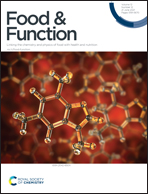Inhibition of the intestinal postprandial glucose transport by gallic acid and gallic acid derivatives†
Abstract
Inhibition of glucose uptake in the intestine through sodium-dependent glucose transporter 1 (SGLT1) or glucose transporter 2 (GLUT2) may be beneficial in controlling postprandial blood glucose levels. Gallic acid and ten of its derivatives were identified in the active fractions of Terminalia chebula Retz. fructus immaturus, a popular edible plant fruit which has previously been associated with the inhibition of glucose uptake. Gallic acid derivatives (methyl gallate, ethyl gallate, pentyl gallate, 3,4,6-tri-O-galloyl-β-D-glucose, and corilagin) showed good glucose transport inhibition with inhibitory rates of 72.1 ± 1.6%, 71.5 ± 1.4%, 79.9 ± 1.2%, 44.7 ± 1.2%, and 75.0 ± 0.7% at 5 mM D-glucose and/or 56.3 ± 2.3, 52.1 ± 3.2%, 70.2 ± 1.7%, 15.6 ± 1.6%, and 37.1 ± 0.8% at 25 mM D-glucose. However, only 3,4,6-tri-O-galloyl-β-D-glucose and corilagin were confirmed GLUT2-specific inhibitors. Whilst some tea flavonoids demonstrated minimal glucose transport inhibition, their gallic acid derivatives strongly inhibited transport effect with GLUT2 specificity. This suggests that gallic acid structures are crucial for glucose transport inhibition. Plants, such as T. chebula, which contain high levels of gallic acid and its derivatives, show promise as natural functional ingredients for inclusion in foods and drinks designed to control postprandial glucose levels.



 Please wait while we load your content...
Please wait while we load your content...